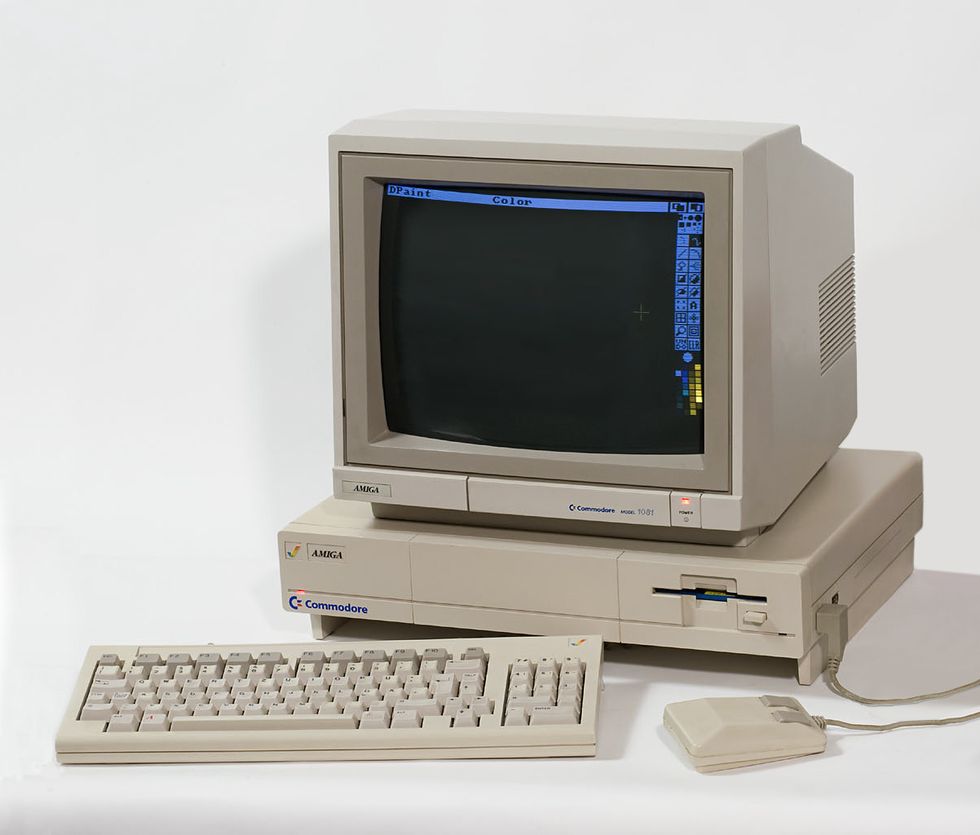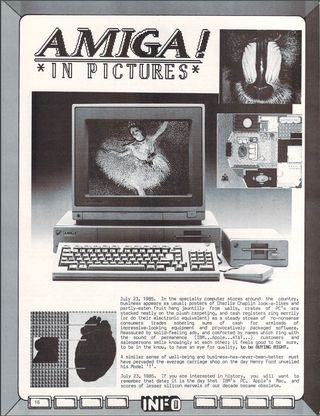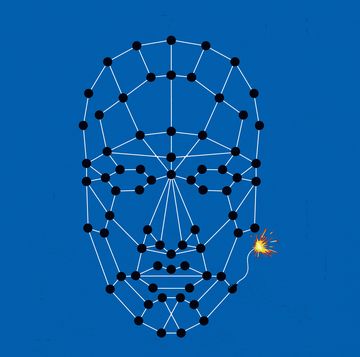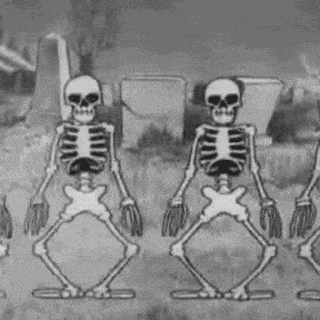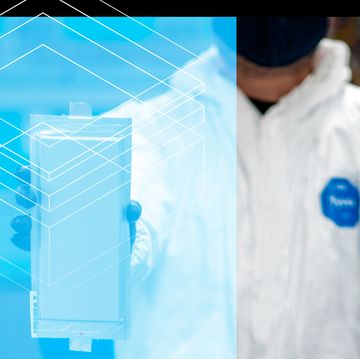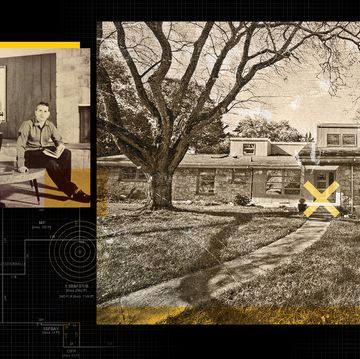Meet the dedicated few who are working in the shadows to keep an ancient suite of software alive, waiting for it to thrive again.
The IBM and Apple machines were better known among the legends of 80s computer. But perhaps no computer was more beloved by its users than the Amiga.
In the mid-1980s, Commodore released the Amiga 1000, a beast of a machine whose specs blew away the hardware of its day, and which became a cult favorite. But by 1995, after several iterations of Amiga and years of questionable decisions by the Commodore company, the Amiga brand closed up shop. In the two decades since then, the rights to the computer and its software suite have been sold off and stuck in legal purgatory. And yet now, a group of hardware enthusiasts are trying to bring the revered 1980s computer into the 21st century.
On an early June day, I watched one of those new old machines come to life. It might just resurrect the Amiga name—if anybody finds out it exists, that is.
The Ferrari of Computers
Jamie Krueger is one of the Amiga's 21st century apostles. Today he is hosting the demo in his apartment in Janesville, Wisc., where a machine from Amiga's alternate future roars to life. Standing in his living room, Krueger relates the strange story of Amiga's first birth and death.
The Amigawas first born at company called Hi-Toro, run by staffers who had recently cut ties with Atari to strike out on their own. There they began an ambitious project reinvent the computer, basing their new device on the Motorola 68000 microprocessor and code-naming it "Lorraine."
Their work did not go unnoticed. After a messy bit of litigation, the company—now renamed to Amiga—was purchased by home computing giant Commodore. It was an odd pairing.
The Commodore 64, released in 1982, had established itself as one of the most popular home computers. With a low price of $595 (equivalent to some $1,500 today), the C64 had saturated the market like none other, but at the cost of using cheap components that caused headaches for plenty of unlucky owners. Still, the Commodore 64 trudged on.
The Amiga 1000, released in 1985, was quite the opposite. It had a sleek quick-load OS that could boot almost instantly. It rocked 256 kilobytes of RAM to the C64's mere 64. It had a 256-color display at a time when the NES could support only 64 and most home computers, including the C64, couldn't juggle more that 16. Amiga brought arcade-quality visuals into your living room. And so it became the computer geek's computer, but not only for its top-tier specs.
"I think the attraction in the programming community was the complete openness of the architecture and the ability to get as much performance out of the hardware as possible," says Dale Luck, who worked on the Amiga graphics library prior to the release of the 1000 and is now a senior software architect at Roku. "It allowed for the development of truly revolutionary games and colorful and easy to use UI."
But the Amiga 1000 was more than just a pretty face. "The Amiga was decades ahead of its time—look no further than preemptive multitasking," says Perry Kivolowitz, a professor of computer science at Carthage College. "The Mac, until OS X, was a cooperative multitasking machine—you've experienced the handicap of this if you've ever seen the Spinning Beach Ball of Death. In a cooperative environment if any task hangs, the computer hangs. On a preemptive system, any hung task slows the machine a small bit but doesn't kill it."
Unsurprisingly, this dream machine did not come cheap. A fully kitted-out Amiga 1000 would set you back $1,790 in 1985. That's more than $4,000 today. It was expensive, but not preposterously so. A basic IBM PC from 1981, despite being considerably less capable, would cost you around $1,600. Lower-end options like the C64, meanwhile, cornered a more casual market with sub-$1,000 prices.
And the Amiga sold. Sales for the entire fleet of Amiga systems, which grew to around a dozen models, reached 4 million by the time Commodore closed its doors in 1994. That's pittance next to the C64's 17 million, but the Amiga was a premium machine. And while the Commodore 64 still holds its retro appeal, the Amiga ascended to a higher plane of nerd. "The Amiga is in the rarified space occupied by old Ferraris, tube-based MacIntosh audio gear and frankly, great old wine," Kivolowitz says.
That loyalty it inspired may not have been enough to save Amiga in the 1990s. But it was more than enough to resurrect it for a second life today.
Across Generations
As I watched Jamie Krueger's AmigaONE X5000 in his living room, I was joined by 19-year-old Jacob Niemuth, a game design student at University of Whitewater. Niemuth wasn't even born until years after Commodore shuttered, but his connection to Amiga is strong.
A self-described retro gamer, Niemuth got his start in Facebook groups by buying and selling old-school hardware, including cathode ray tube monitors and, of course, Amigas. He has an Amiga 2000—a 1987 model that's older than he is—that he uses to write chiptunes and to explore the games of the past in their natural habitat.
"There are a lot of games for it, and the music's awesome too," he tells me. His favorites are Battle Squadron, Ork, and a port of Galaga. One of his current projects is backing up Krueger's software library to a home server. There are more than 2,000 Amiga discs in his collection.
Niemuth's Amiga 2000 isn't an off-the-shelf model straight out of an 80s catalog. It's souped-up, with an ethernet port—though the machine's built-in browser that can barely handle the modern web—and has hardware tweaks as well, such as a video card to push resolutions past the limits of yesteryear. His goal is to build a machine that might even be cable of Twitch stream editing, someday. "I'm nearly dumping $1,000 into a 30-year-old computer," Niemuth says with a smile and a sigh.
When you do so much custom tinkering, setting up the system can require a little troubleshooting. During the process, Niemuth and Krueger try out a series of monitors from a collection in Krueger's basement, a stockpile of some 20 or so machines built up during his years working as a computer repairman. Many of those machines, unsurprisingly, are Amigas.
"My first Amiga was an Amiga 500, and that just opened my world," Krueger says. It wasn't just the computer itself he loved, but also its potential. One of the Amiga's most appreciated features was built-in room for hardware enhancements that could operate almost entirely independently of the Amiga's main computational brain.
"A great deal of what you could do on the Amiga were things you could do without the CPU at all," Krueger says. This was thanks to the Amiga operating system that could handle various processes simultaneously. One of these chips, the Video Toaster, became one of the most famous video hardware devices, providing capabilities that Krueger compares to "taking a TV station and put it on a card."
That unique power is what has kept enthusiasts like Krueger from abandoning the Amiga dream, despite the how rocky the road has gotten.
From the Ashes
The path from Commodore's demise in 1994 to the AmigaONE X5000 today is a winding one, full of the arcane twists and turns of intellectual property law. The basics go a little something like this.
After Commodore folded, the Amiga name went to a company called Escom, which put out two new computers with leftover parts before being acquired by Gateway. There, the Amiga name languished for two years before two of Gateway's own engineers bought the rights for $5 million and incorporated Amiga Inc. in 1999. In the early 2000s they strove to bring back the classic name with "Amiga Anywhere," a bid to create a multi-platform software environment that could run on the lion's share of mobile and desktop operating systems of the day, enabling a sort of universal app store long before Android or iOS ever existed.
Krueger, who worked on the project, sums up its fate with no sugarcoating. "Amiga Anywhere went nowhere. It was a fantastic idea that could have dominated the emerging mobile device market if Amiga Inc. had been able to pull it off. Unfortunately, they ultimately did not have the resources to make it happen."
Meanwhile, Amiga's attempts to update its traditional desktop software was met with legal complications. When Amiga hired a company called Hyperion to port the AmigaOS to PowerPC processors, which would allow Amiga's OS to expand to non-Amiga hardware—the two got tangled in a lawsuit that saw Hyperion emerge with exclusive rights to both the Amiga logo and the next generation of Amiga software—versions 4.0 and beyond.
Outside of emulation, the only way to run AmigaOS 4.0 or 4.1 is to get new Amiga hardware, now produced chiefly by a company called A-EON, run by Trevor Dickinson. He produces new hardware under the name AmigaONE, with two models called the X1000 and X5000, and works closely with Hyperion. Neither of those machines are cheap, though. The X1000 is $2,300, while the X5000 will run you $1,900.
"The single biggest problem with the Amiga computer system today is the cost," Krueger says. "The next biggest challenge is software." That's because, well, there isn't much.
There are somewhere between 1,000 and 2,000 of these neo-Amiga machines out there. So the developer community is small, though Krueger prefers to characterize the situation as an "open market." After all, there is high demand among the otherwise small fanbase, but low supply. The machines are in desperate need of basic digital amenities like an office suite or a modern web browser. It's not as easy as just making an Amiga port of Firefox either. The DNA of the Amiga's operating system necessitates that its software be built from the ground up, and the community is small enough that creating new applications from scratch is a real challenge.
And yet, Krueger says, the modern Amiga community is fractured by infighting. The small coterie of retailers selling motherboards, cases, peripherals, and otherAmiga hardware are prone to falling into petty feuds. Amiga on the Lake, the only online retailer for Amiga in North America, recently stopped carrying A-EON devices and anything sold by the European store AmigaKit over an undisclosed disagreement. "We are still here and 'WILL' be carrying more stuff soon. However no more X5000 or A1222 or, frankly anything produced from either company," Amiga on the Lake said in a statement on its website. However, a month or so after this disagreement, it seems to be resolved.
"It comes to a breakdown in communication," Krueger said. He wouldn't elaborate further when asked about the root of the problem, not wanting to upset delicate negotiations.
The New New Future
The resolution paves the way for what some in the community hope will be a game changer: the A1222. Also known as the "Tabor" this new model is designed to be the first "entry level" A-EON computer. The board will be priced around $500—much, much less than that of the X1000 or X5000. The tradeoff is that it will have a slightly less powerful processor than the X5000, the current "budget" option.
"I think we will sell quite a few of them," Krueger says, framing the A-EON's success as a boon for the community as a whole and emphasizing its collective urge to grow. "That's the goal anyway."
If anyone finds out, that is. The modern church of Amiga is small, but every bit of news is a change to gain a few converts. A review of the X5000 showed up on Ars Technica, but more important than the generally favorable review was the mention it exists at all.
"It's tough," Krueger said. "It's really tough to make a living as a developer exclusively for the AmigaOS."
But there might just be a silent market for these resurrected retro computers, full of folks who just haven't yet heard the news. I texted a picture of one of the new Amiga rigs to my own uncle, who had gotten his start on an Amiga word processor so many decades ago. His Amiga was the second computer I ever saw up close, after my brother's Commodore. Before I knew it, we were on the phone and chatting for only the second or third time in my life.
"Bizarre it's still kicking," he said, tying up some 20 minutes of enthusiastic reminiscing, a heartfelt and off-the-cuff endorsement of the aging tech that I could tell surprised him as much as it surprised me. He hadn't heard about the new rigs. Now that he has, he certainly won't forget.
